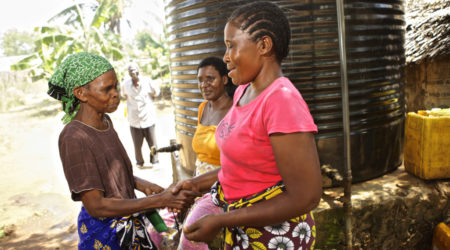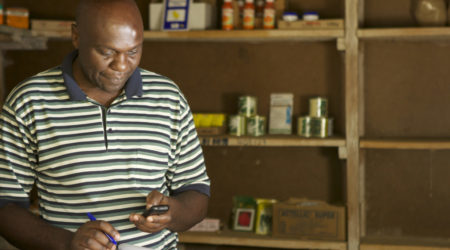The ultimate stress test for financial resilience

Originally posted on the FSD Kenya Website, April 7, 2020
How coronavirus adaptations are straining Kenyans’ most robust financial coping mechanisms
“I wasn’t prepared for this virus,” Rachel told us over the phone. Just two weeks after the first coronavirus (COVID-19) case was confirmed in Kenya and three days after a nationwide curfew from 7 pm to 5 am began, she and her husband, Paul, were already on edge wondering how they will make it through.
Trying to understand the impact of coronavirus on ordinary Kenyans, BFA Global and FSD Kenya have been working together to interview former Kenya Financial Diaries participants over the phone and see how they are navigating the crisis. Our relationships with respondents go back to 2012, providing us a basis for in-depth research without being physically present.
Our first 40 interviews are already providing powerful insights to how Kenyans are adapting economically to health fears, social distancing, curfews, and a significant drop in business sales and wage work. While the initial Kenya Financial Diaries project (2012-2013) and the 2015 Diaries Update studies showed us how incredibly resilient Kenyan families could be, we are already seeing the usual, very powerful coping mechanisms used by so many being put to their ultimate test right now. As the crisis becomes prolonged, many families will run out of options to meet their most basic needs.
Rachel and Paul on the edge
For Rachel and Paul, money was tight even before the virus found its way to Kenya. The two live in an urban settlement in Mombasa, and Rachel had been making most of her money from selling Forever Living products. Most of her clients were long-distance truck drivers who used to pick up their cargo in Mombasa. The Standard Gauge Railroad and endless road construction slashed the numbers of trucks on the road and resulted in hundreds of job losses for truck drivers and their assistants. Her clientele dwindled.
She shifted to selling coffee and groundnuts in the evenings, mostly to workers from the Export Processing Zone (EPZ). As soon as the virus hit, those factories closed and many of the workers—her clients—moved to their upcountry homes. And then came the curfew, preventing her from working in her peak after-work hours.
Most of my clients leave work at around 5 pm, and by the time they get to the neighbourhood, it’s a few minutes to 7 pm due to traffic jams and some preferring to walk home. At this point, the clients prefer going straight to buy food for supper before selling points are closed because of the curfew. There is a community alarm that goes off warning people that they should start going home as the curfew is about to begin. Within no time the police come and start dispersing people. Some customers start running away without even paying me.
She’s had to cut back on how much credit she can extend her customers.
I used to have some customers who would pay me weekly, fortnightly, and monthly, lining up with however they were paid at work. I can’t do that anymore. I don’t know if people will be able to pay given this virus issue. I also have to buy stock and feed my family.
She tells us she will have to get creative to keep some income coming into the house:
Instead of selling coffee in the evening, I’m going to try and start selling at 2pm by hawking it to any willing buyer I can find door-to-door. Immediately when I hand you coffee, you pay, so that if I have to run from police, I can be done with you and won’t lose money. This might help me boost my sales and cut my losses.
Paul’s business has had to stop completely because of the virus. “I’m the only breadwinner now,” Rachel tells us. Customers have evaporated for all kinds of businesses and casual workers have no way to earn an income. Rachel feels lucky that even though her revenues are down by about half, there’s still some money coming through the door. There’s still food in her local shops, too. “What’s missing is money!” she says.
The financial squeeze has made it harder for her to send money to her mother in Kitale. “I normally send my mom Ksh 200 (about $2) daily for her chama and daily spending, but this month, I’ve had to only send Ksh 100 ($1).” Her mother was asking her to send Ksh 700 ($7) so they could buy some farming inputs, but Rachel just couldn’t do it. If things get worse, she tells us she’ll have to stop sending her mom money completely.
Before, she might have turned to her chama savings to help her through a time like this, but she stopped using chamas. In December, she lost Ksh 120,000 ($1,200) she had saved for more than a year—at least KSH 200 ($2) per day—when a member of her group ran away with the entire group fund of Ksh 700,000 ($7,000). She had really hoped to use that money to expand her business. She was too demoralised to start saving again.
Rachel’s already used up her borrowing capacity as well, taking a Ksh 2,000 ($20) loan from a local moneylender. She owes Ksh 600 ($6) in interest on top of the principal. If she doesn’t pay on time, the interest will keep accumulating.
One small mercy is that Rachel and Paul aren’t paying rent. Their flat is owned by Paul’s family; they just have to pay about Ksh 500 ($5) per month for electricity.
If things get much worse, what will you do? “We have nowhere to turn. We will just wait for our death,” Rachel responds. But she hopes it won’t get to that. “If things get really bad, the government will have to intervene. They will have no choice,” she adds.
Echoes around the country
The strain on traditional coping mechanisms is something we’re hearing about around the country. When we examined how families coped with risk in the Financial Diaries, we saw that the most important coping mechanisms for small shocks were saving in the house and shop credit. Now, families have tried to stock up on food and essentials, but often didn’t have sufficient savings to stock up very much. Even back in 2015, the median household had saved only about 22 days’ worth of income in ALL their financial assets, with only a small share of those savings held in liquid form. Most urban households are telling us that they have about 1-10 days’ worth of food in the house now. Rural households have a bit more, thanks to a generous harvest in many areas last year. But cash is now stretched thin, just as people like Rachel are tightening up the credit they used to extend to clients. Shopkeepers and other vendors are concerned about their own ability to stock their shelves and their clients’ abilities to quickly pay debts. They are sometimes paying more to stock as well, particularly as some suppliers close, forcing them to travel farther to stock and spending more as transport prices increase as supply falls and some transporters face volume restrictions. Many open markets have been forced to close.
On top of this, many savings groups, or “chamas”, have stopped operating. Some because few members have incomes right now to contribute, others because it’s simply too hard to discuss financial matters by phone, and still others because area chiefs have mandated chamas to close. When many members face a shock at the same time, these kinds of group saving and risk management schemes lose much of their power anyway. But with chamas closed down, members can’t get their savings back or take new loans against the group fund.
Some, like Rachel, have taken loans from moneylenders and still others from digital lenders like M-Shwari and KCB M-Pesa. As the crisis gets prolonged, how long will those sources of liquidity remain available as more and more borrowers struggle to repay?
At other times in the past, a struggling family might seek to earn more income to make ends meet, often one of the adults picking up extra work. That is almost impossible now as work of all kinds—formal and informal—becomes scarce. In some areas, travel to areas where work may still exist could be impossible. While many families used to manage financial responsibilities between spouses, earmarking one income for day to day expenditures and another for loan payments and bigger investments in things like school fees and business expansion, this is no longer possible. Very few families we’ve spoken with still have multiple adults actively earning an income.
And perhaps most worrying of all, the most important source of coping with big shocks has always been the social network. Remitters would come together to help families deal with the biggest risks they faced, like hospitalisation and deaths in the family. For many rural households—27% in the Financial Diaries—remittances were the most important source of monetary income even in ordinary times. As remittance senders see their incomes collapse, rural recipients worry how they will get by. They worry even that their children and spouses in urban areas will come home—likely empty-handed and potentially carrying what is seen as an urban virus—creating new burdens on existing food reserves.
Strategies of last resort
We are already seeing some strategies of financial desperation kicking in. Many families have already reduced the number of meals they are eating each day. Worried about the future, they are not inclined to share more with neighbours. They are worried about safeguarding what they have.
When we ask, as we did Rachel, how they might cope if things get even worse, we hear about the likely emergence of bartering with neighbours to get by. Some hope they will be able to sell or barter assets, particularly chickens, goats, and cows, even as traditional markets for selling their goods have disappeared. We also hear respondents only two weeks into this ordeal desperately hoping that Government and God will intercede.
Long-term Consequences
The strain on Kenyans’ financial coping mechanisms is worrying not just for the immediate impacts on people’s health and welfare, but also in terms of long-term recovery prospects. For example, many rural families were telling us they were counting on remittances or the savings they’ve already spent on food to finance farming inputs for this planting season. What will happen to agricultural production this year if those investments are impossible? A large number of Kenyans—35% of our Financial Diaries sample as of 2015—rely on self-employment livelihoods. If savings and lines of credit are already exhausted, how will they find the capital they need to restart when the crisis abates? On the upside, our previous research indicates that very low levels of capital are often enough to start again, with the median business in our sample starting with just Ksh 600 ($6).
Imagining a response
With Kenyans’ robust coping strategies already under strain in the early days of this global health crisis, practitioners need to imagine large responses that both help families get by in the short term and put them in a position to thrive once again when it’s safe to get back to business.
This is part of a series of rapidly-produced blogs on how low-income Kenyans are coping with the changes in their lives induced by the novel Coronavirus (COVID-19). This research was implemented in partnership between BFA Global and FSD Kenya. Read more about the Kenya Financial Diaries project here. We will continue checking in with Diaries participants throughout the crisis. For the latest news and insights from this work, follow @FSDKe and @BFAGlobal on Twitter, as well as hashtags #Covid19DiariesKenya and #KomeshaCorona.



